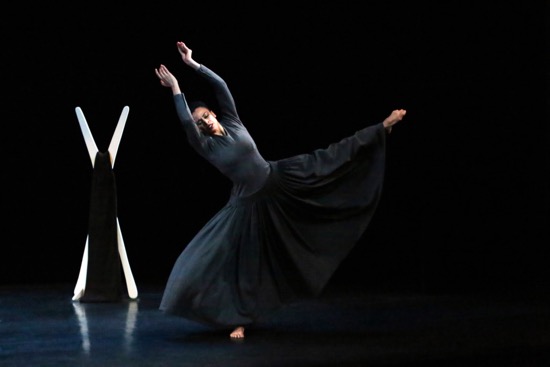
The Martha Graham Dance Company has titled its season at the Joyce Theater “The Eve Project.” What did artistic director Janet Eilber mean by this? Forget about Eve being conned by the biblical serpent; she tempted Adam to bite into that apple and, according to the bevy of gospel writers, more or less invented sex and paid the price. Instead, every one of the eleven works being performed between April 2nd and April 14th was choreographed by a woman—seven of them by Graham and the remaining four by Pam Tanowitz, Lucinda Childs, Annie-B Parson, and the duo Maxine Doyle and Bobbi Jene Smith.
The very title of Graham’s Secular Games (1962) exempts it from biblical interpretation. The splendid first section, “Play—on a Socratic Island,” is performed by six splendid, bare-chested men (Alessio Crognale, Lloyd Knight, Jacob Larsen, Lloyd Mayor, Ernesto Pagnano, and Ben Schultz). They toss a ball about or recline on low stools in positions that evoke the diners in Plato’s Symposium or fifth-century B.C. marble statues. These men’s discourse speeds up and slows down via acrobatic display—leaps and spins and cartwheels— rather than words, and unlike those ancient celebrants, they have clearly drunk no wine. The ball measures about 8 inches in diameter, and the dexterity with which they toss and catch it is remarkable: a long shot over someone’s head here, a short low pass there. They’re sly about it too and may grab a moment to whisper in this one’s ear or take a time out. The game isn’t fierce and competitive, just something symbolically resonant to do on a sunny day.
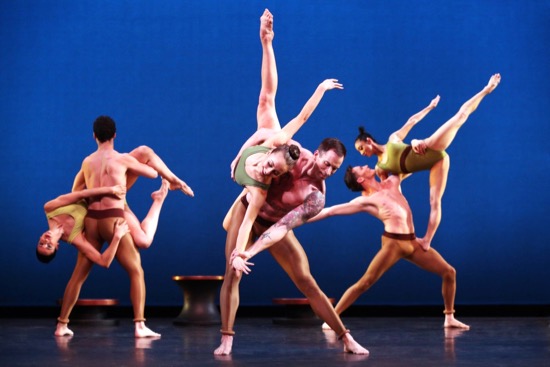
The score—Robert Starer’s Concerto a Tre—velvet-gloves its boisterousness for the next scene, subtitled “Play with Dream—on a Utopian island.” Four nymphs in leotards (Charlotte Landreau, Marzia Memoli, Anne Souder, and Lesley Andrea Williams) frolic on the floor, kicking their legs into the air. Tall Natasha M. Diamond-Walker is on view as well; so is So Young An, who gets draped in a length of yellow cloth that, unfurled and laid out, suggests a small strip of beach for others to lounge behind. She becomes upset (I’m not sure why) and wipes her eyes. Knight, and Schultz interlock with Laurel Dalley Smith in adventurous ways. If the men of the first section suggest Socrates’ thinking and drinking companions, the women are more like mischievous (and athletic) questioners. In the third part of Secular Games, “Play—on any Island—,”men and women pair up, and five couples take swift turns in the limelight. When Mayor bends down in front of Landreau, his arms encircling her body and legs, she wriggles excitedly (could she be getting out of her bathing suit or just her inhibitions?).
Secular Games begins the evening. Then we’re plunged into a dark place of the soul: Graham’s masterly 1944 duet Hérodiade. Peiju Chien-Pott assumes the role that was originally Graham’s: A Woman. In the cast I saw, Diamond-Walker played Her Attendant. Both women are beautiful dancers and, appropriately, do not “act” emotions but let us understand these through their actions and focus.
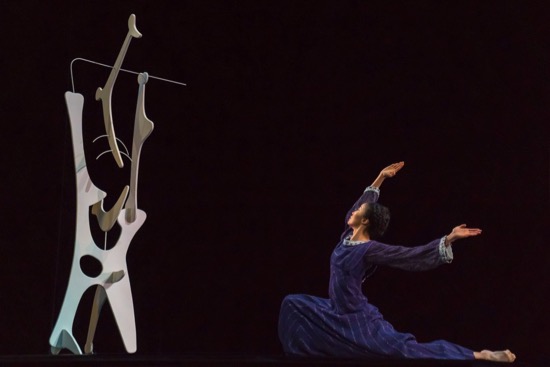
Paul Hindemith’s music is titled after Stéphane Mallarmé’s poem, Hérodiade, and its rhythms and qualities embody the twinned psyches of the biblical Herodias and her daughter Salome, who asked King Herod to slay John the Baptist in exchange for her dancing. Graham, however, tells no such story. The setting is an antechamber, a waiting room, and the Woman is facing a decision that requires much courage. Isamu Noguchi created the duet’s three white set pieces—functioning as a chair, a clothes rack, and a mirror. Formally allied with his sculptures of the time, the towering “mirror” is constructed of two-dimensional white shapes locked together into three-dimensionality. Graham saw it as “a skeleton. The ribs are there. The bird that lies in the heart is there” And she also wrote that “When a woman looks into a mirror. . .and if she’s approaching the time when she’s no longer young, she sees her skeleton, she sees her bones.” (In 1944, Graham turned fifty).
Chien-Pott appears from behind a high, irregularly shaped “wall” at the back and paces the distances between these objects. Although she circles the chair, she seems to favor walking in straight lines. And it is primarily the “mirror” that draws her. Staring at it, she jumps straight up, legs bent, over and over, accumulating speed until she falls. Diamond-Walker plays the role designed for May O’Donnell. Unlike the tense heroine, who at one point narrows her silhouette by wrapping her skirt tightly around her hips, the other woman spreads her feet wide apart. She sinks into servile positions, while also seeming to dissuade or protect her mistress. She removes Chien-Pott’s invisible shoes and later gets slapped for hovering too closely. Once, curiously, she stands behind the “mirror,” so that Chien-Pott sees her, instead of her own imagined reflection.
The ending of the reconstructed Hérodiade puzzles me in terms of history. As the beginning of the heroine’s ordeal approaches, the Attendant ceremoniously divests her of her heavy gown, leaving her in a simple white one. But this resolute woman, unlike the one in an old record film of the duet, doesn’t wrap herself in the black cloth that’s been hanging on the clothes rack and then leave the stage, Instead, she remains there, after the attendant has carefully laid the cloth out on the chair and exited. Perhaps Graham herself changed the ending at a later date?
This program at the Joyce (one of six all told) is a strenuous one. Only pauses separate the first dance from the second one and the second from the third. Deo, a world premiere, has been co-choreographed by Maxine Doyle (the co-director of Punch Drunk’s Sleep No More) and Bobbi Jene Smith (formerly of Batsheva Dance Company and also involved in Sleep No More). It’s a fascinating piece, but not an easy one to absorb. Its eight women (all but Xin Ying already mentioned) dwell in a dark place, made deeply golden by beams of light and at times pierced by fog (lighting by Yi-Chung Chen).
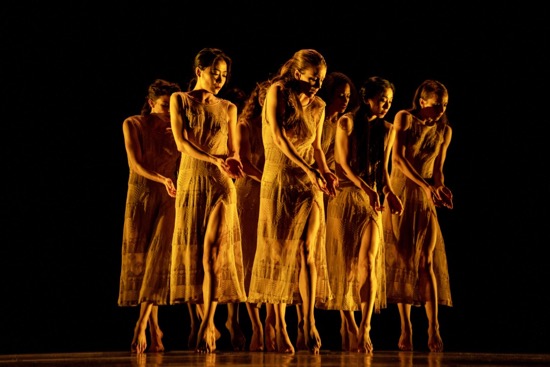
Lesley Flanigan’s music begins with a held note that seems unbearable long before it breaks down. That the title refers to the Christian God suggests that this dark world of women is perhaps a hell of their own making. The program note and the witty pre-curtain speech by Janet Eilber refer to the myth of Demeter the earth goddess, who searches for her daughter Persephone, condemned to spend six months of the year in Hades. But Doyle and Smith are not re-telling that story. Only the dancers’ frequent upward gazes imply a happier world they’ve fallen from.
They are identically garbed in long, pale translucent dresses by Karen Young (the program tells us that these are based on the Heirloom Dress from Levi’s Made and Crafted Collection). And much of what these unhappy women do, they do together, as if by innate understanding, rather than by agreement. They throng together and clutch themselves. They form lines and travel together across the stage. They lie supine, spaced out over the floor, and lift their heads slightly. Later, they lie face down and raise their feet. They march together, kneel, and convulse. They often dance, low to the ground, their legs spraddled, their bodies hunched and twisting. Reaching out, they pull in air, as if gleaning it. One woman races furiously in a circle. Memoli dances alone, while, upstage, their backs to us, the other women hold hands and make their line ripple and ebb repeatedly, like a wave breaking over and over without traveling through space. Sudden blackouts punctuate the actions, suggesting the passage of years. The only hint of the Persephone legend that I can discern comes from the women’s frequent upward focus, as well as from the pairing or separating of two of them or the wild frenzy of one.
Doyle and Smith drew some of their movement vocabulary from Graham’s repertory (as did Pam Tanowitz for her Untitled Souvenir, which appears on Progams B and C). And after a much-needed intermission, Annie-B Parson’s terrifically crazy 2017 I used to love you does the same, albeit in a very different way. Parson took images from Graham’s 1941 satire on domesticity, Punch and the Judy, and re-imagined them. Sketches plus clips from an old black-and-white film of it blur and swim and fracture in the storms of Jeff Larson’s brilliant video. A globe onstage in 1941 becomes a looming image of planet earth. All this is projected onto a large home-movie screen that can be rolled down or, when extended, hide illicit romancing. Tel Blow created the sound design, Nick Hung did the lighting, and Aaron Mattocks co-directed the revival.
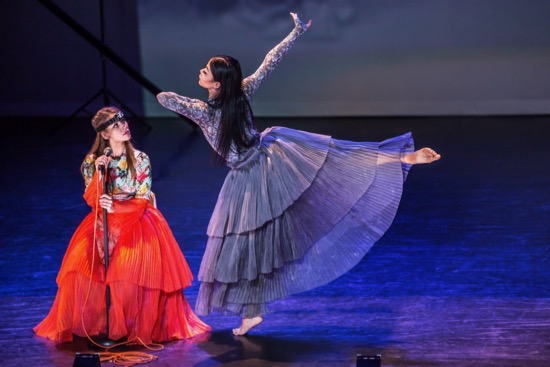
Instead of the Three Fates in 19th-century dresses who, clustered together, watched, talked about, and interfered with the action in Graham’s Punch and the Judy, we get Dalley Smith, Anne O’Donnell, and Leslie Ann Williams, wearing wonderfully vivid dresses by Oana Botez and sitting in chairs lined up across the front of the stage. Grabbing mics that trail long colored wires, they tell us of the goings on, argue, and warn us of what might happen (the text by Will Eno is a deliciously savvy one). At one point, in search of “The Truth,” they don small headlamps. Since their chairs have wheels, the three also skim over the stage like witches trying to get a better view of the goings on. At another time, the remaining cast members, Lorenzo Pagano and Ben Schultz, spin them around in a tight circle as if trying to shake the story out of them.
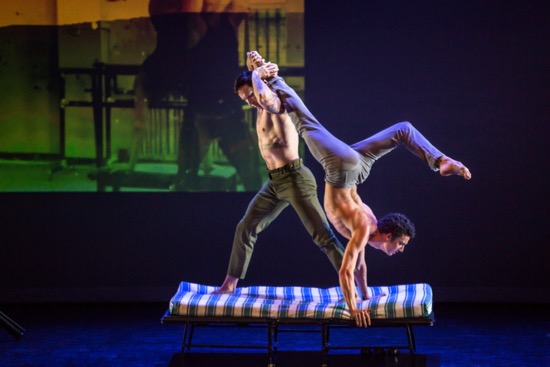
Occasionally history and the present coincide. We see tiny, blurry black-and-white Martha Graham sitting on the floor to rock Nina Fonaroff as Punch and Judy’s child, while flesh-and-blood Ying rocks An. Pagano masquerades as Erick Hawkins (Graham’s lover), disguised by her in 1941 as the strutting, doltish Punch who has trouble getting out of bed in the morning. Back then, Merce Cunningham played Pegasus, the winged horse who delivers inspiration to the Graham heroine, portrayed as an often-at-a-loss choreographer bullied by her own creations. In Parson’s ingenious work, however, Schultz and Pagano not only play rivals, but briefly and formally make out on the narrow cot and then lie side by side while Ying storms around. (Knowing the strained relationship between Hawkins and Cunningham, I seriously doubt that an affair actually happened, although it could perhaps have been a jealous thought that occurred to Graham. More likely: her avatar in the dance was fusing the men in her mind, as she debated how best to make use of them).
After watching the superb Graham dancers perform her iconic works and venture beyond them, the image of Graham herself sometimes slides into my mind. Would the works by other choreographers please or baffle her? Would she be delighted and honored by the reconstructions of her dances, or furious? Would she lash out, or wade in and start doling out minor corrections? I like thinking the latter; she is one powerful ghost.

“she is one powerful ghost…”
That just about says it all, Deborah, summing up this very interesting review as well as her place in the history of American dance and the national psyche so to speak. Wouldn’t it be interesting as well if someone were to choreograph a piece about Hamlet confronting his father’s ghost, using Graham’s vocabulary and female dancers performing both roles? Thanks again for putting me in the theater with you, next best thing to being there.